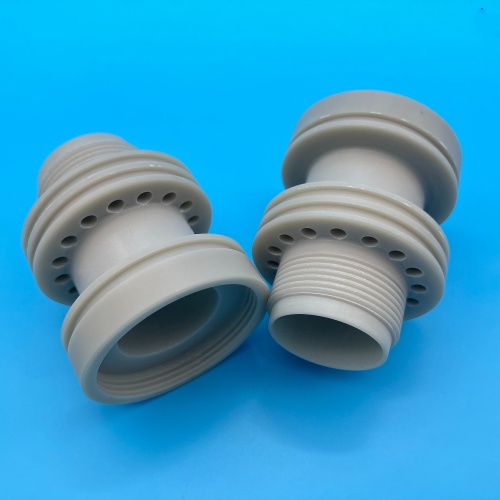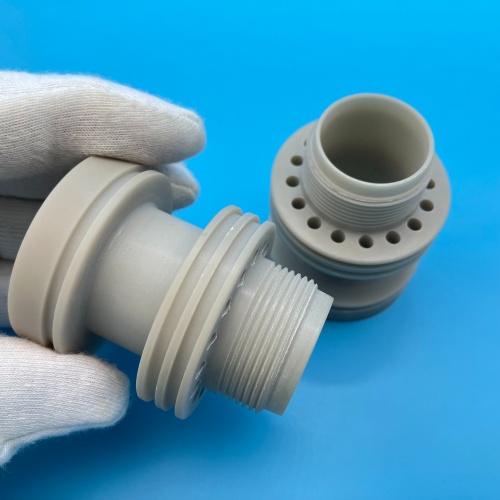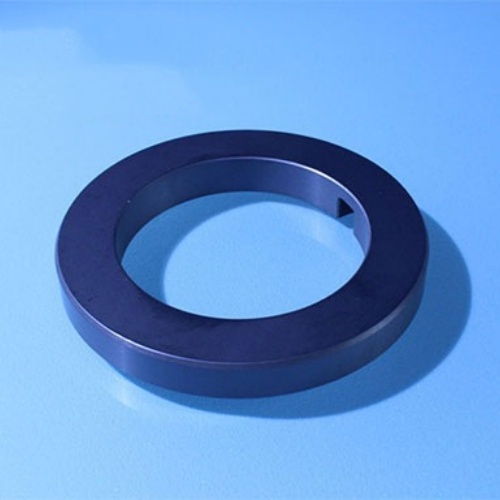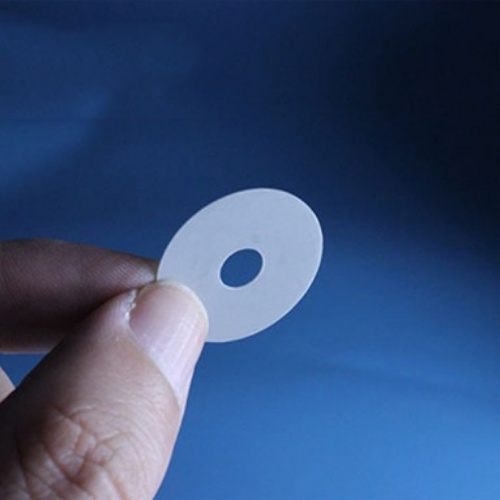Aluminum nitride (AlN) ceramic structural components are high-performance precision parts prepared from high-purity aluminum nitride powder through advanced ceramic molding and sintering processes. With its ultra-high thermal conductivity, excellent electrical insulation, good mechanical strength, and thermal stability, it is widely used in fields such as electronic heat dissipation, power electronics, semiconductor manufacturing, laser technology, etc., especially suitable for high-density integrated systems with strict thermal management requirements.
Core material advantages
Characteristics of Aluminum Nitride (AlN)
Ultra high thermal conductivity: The thermal conductivity can reach 180-230 W/(m · K) (close to metallic aluminum), which is 5-8 times higher than aluminum oxide, effectively dissipating local hotspots.
Excellent electrical insulation: volume resistivity>10 ¹⁴Ω· cm, breakdown strength>15 kV/mm, suitable for high voltage and high electric field environments.
Low thermal expansion coefficient: Excellent compatibility with silicon (CTE ≈ 4.2 ppm/℃), avoiding interface failure caused by thermal stress.
High temperature stability: Long term use temperature>800 ℃, short-term tolerance above 1200 ℃, stable performance under vacuum or inert atmosphere.
High mechanical strength: bending strength ≥ 350 MPa, hardness HV ≈ 1200, suitable for processing complex structures.

Comparative advantages of materials
Performance indicators: Aluminum Nitride (AlN), Aluminum Oxide (Al ₂ O3), Beryllium Oxide (BeO), Copper Metal (Cu)
Thermal conductivity (W/(m · K)) 180~230 20~40 300~350 401
Excellent electrical insulation (volume resistivity>10 ¹⁴) Excellent (volume resistivity>10 ¹²) Excellent (volume resistivity>10 ¹³) Conductivity
Density (g/cm ³) 3.26 3.9~4.0 2.85 8.96
Toxic, non-toxic, highly toxic, non-toxic
The processing cost is relatively high, low, extremely high (special protection is required for highly toxic substances), and low (secondary processing is required)
Product Design and Process
Structure Design
Thermal simulation optimization: Design heat dissipation teeth, flow channels, and other structures through finite element analysis (FEA) to maximize heat transfer efficiency.
Precision molding: supports the design of complex geometric shapes (such as micro hole arrays and irregular grooves) to enhance the effective heat dissipation area.
Metalization process: The surface can be plated with gold, silver, copper, or welded with molybdenum sheets to achieve high reliability connection between ceramics and metals.
manufacturing process
Powder processing: High purity AlN powder (purity ≥ 99.5%, D50<1 μ m) is mixed with sintering aids for granulation. Molding technology: injection molding, dry compression molding or gel injection molding, with an accuracy of ± 0.01mm. Sintering process: atmospheric pressure sintering (1800-1900 ℃) or hot pressing sintering (HPS), resulting in a density greater than 99%. Post processing: Diamond grinding, laser cutting, chemical polishing, surface roughness Ra ≤ 0.2 μ m. Key performance parameters Detailed indicators for parameter categories Thermal conductivity of 180-230 W/(m · K) (25 ℃), slowly decreases with increasing temperature (still>100 W/(m · K) at 800 ℃)
Electrical insulation volume resistivity>10 ¹⁴Ω· cm (25 ℃), dielectric constant ≈ 8.5 (1MHz)
The coefficient of thermal expansion (CTE) is 4.0~4.5 ppm/℃ (25~800 ℃), which is highly compatible with Si (4.2 ppm/℃) and GaAs (5.8 ppm/℃)
Bending strength ≥ 350 MPa (25 ℃), ≥ 200 MPa(800℃)
Fracture toughness of 3.5~4.0 MPa · m ¹/²
Long term use of working temperature: ≤ 800 ℃; Short term limit: 1200 ℃ (inert atmosphere)
Dimensional accuracy injection molding: ± 0.01mm; Dry pressing molding: ± 0.02mm
Surface roughness: Ra ≤ 0.2 μ m after grinding, Ra ≤ 0.05 μ m after polishing

Typical application scenarios
Electronic heat dissipation field
High power LED heat sink: replaces traditional metal heat sinks, improves heat dissipation efficiency by more than 30%, and extends LED life.
IGBT module substrate: solves the high temperature problem of SiC/GaN devices and reduces thermal resistance to below 0.2 K/W.
5G base station filter: with high thermal conductivity and low loss characteristics, suitable for high-frequency and high-power scenarios.
Semiconductor Manufacturing Equipment
Electrostatic Chuck (ESC): High insulation to prevent circuit short circuits, uniform thermal distribution to improve wafer processing yield.
Vacuum chamber components: resistant to radiation and plasma corrosion, suitable for etching machines and PVD equipment.
Laser and Optoelectronics
Laser heat sink: efficiently conducts pump light heat and stabilizes laser output power.
Optical component bracket: Low thermal expansion ensures optical path stability and is suitable for high-precision laser systems.
New energy vehicles
Car charging module heat dissipation: to meet the thermal management challenge of 800V high-voltage platform, reducing the volume by 40%.
Battery module end board: insulation, thermal conductivity, and lightweight three in one design to enhance battery safety.
Customized services
Material modification: Adding second phases such as SiC and BN to enhance thermal shock resistance or lubricity.
Structural design: Based on thermal mechanical coupling simulation, provide topology optimization solutions.
Metalization process: Develop Au/Ag/Cu metallization system to adapt to different welding processes.
Coating services: Deposition of DLC, SiO ₂ and other coatings to enhance surface hydrophobicity or wear resistance.

Precision high thermal conductivity insulated aluminum nitride structural components provide revolutionary solutions for electronic devices, semiconductor manufacturing, new energy and other fields with ultimate thermal management performance and material reliability. Whether it is improving heat dissipation efficiency, optimizing equipment volume, or enhancing system stability, it demonstrates advantages that traditional materials cannot match. If you need detailed technical information, sample testing, or customized design, please feel free to contact us to explore the infinite possibilities of aluminum nitride ceramics together!
CATEGORIES
LATEST NEWS
- What are the advantages of ...
- The manufacturing method of...
- Application scope of zircon...
- What are the difficulties i...
- What are the advantages of ...
- Application of Zirconia Cer...
- What are the applications o...
- What are the process method...
- What are the applications o...
- Where is the wide applicati...


